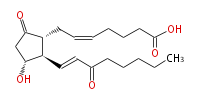LBF20207PG24: Difference between revisions
No edit summary |
No edit summary |
||
| Line 13: | Line 13: | ||
|Chemical Synthesis= | |Chemical Synthesis= | ||
|Metabolism=15-Keto-prostaglandin E2 is further metabolized by its <FONT FACE="Symbol">D</FONT>13-reduction, <FONT FACE="Symbol">b</FONT>-oxidation and <FONT FACE="Symbol">w</FONT> oxidation. The ultimate metabolite is (7<FONT FACE="Symbol">a</FONT>-hydroxy-5,11-diketotetranorprosta-1,16-dioic acid) and excreted in urine [[Reference:Hamberg_M:Samuelsson_B:,J. Biol. Chem.,1971,246,6713|{{RelationTable/GetFirstAuthor|Reference:Hamberg_M:Samuelsson_B:,J. Biol. Chem.,1971,246,6713}}]]. | |Metabolism=15-Keto-prostaglandin E2 is further metabolized by its <FONT FACE="Symbol">D</FONT>13-reduction, <FONT FACE="Symbol">b</FONT>-oxidation and <FONT FACE="Symbol">w</FONT> oxidation. The ultimate metabolite is (7<FONT FACE="Symbol">a</FONT>-hydroxy-5,11-diketotetranorprosta-1,16-dioic acid) and excreted in urine [[Reference:Hamberg_M:Samuelsson_B:,J. Biol. Chem.,1971,246,6713|{{RelationTable/GetFirstAuthor|Reference:Hamberg_M:Samuelsson_B:,J. Biol. Chem.,1971,246,6713}}]]. | ||
|Symbol=15-KETO-PGE2 | |||
|Biological Activity=It is well known that the biological activities of various prostaglandins are reduced upon their dehydrogenation at carbon-15 by the catalysis of 15-hydroxyprostaglandin dehydrogenase [[Reference:Anggard_E:,Acta Physiol. Scand.,1966,66,509|{{RelationTable/GetFirstAuthor|Reference:Anggard_E:,Acta Physiol. Scand.,1966,66,509}}]]. | |||
}} | }} | ||
{{Lipid/Footer}} | {{Lipid/Footer}} | ||
Revision as of 21:00, 6 January 2010
| LipidBank Top (トップ) |
Fatty acid (脂肪酸) |
Glycerolipid (グリセロ脂質) |
Sphingolipid (スフィンゴ脂質) |
Journals (雑誌一覧) |
How to edit (ページの書き方) |
| IDs and Links | |
|---|---|
| LipidBank | XPR1411 |
| LipidMaps | LMFA03010030 |
| CAS | |
| KEGG | {{{KEGG}}} |
| KNApSAcK | {{{KNApSAcK}}} |
| mol | LBF20207PG24 |
| 15-KETOPROSTAGLANDIN E2 | |
|---|---|

| |
| Structural Information | |
| 7- [ 3 (R) -Hydroxy-2 (R) - (3-oxo-1 (E) -octenyl) -5-oxocyclopentan-1 (R) -yl ] -5 (Z) -heptenoic acid | |
| |
| 15-KETO-PGE2 | |
| Formula | C20H30O5 |
| Exact Mass | 350.20932407 |
| Average Mass | 350.4492 |
| SMILES | C(CCC(=O)C=C[C@H]([C@H]1CC=CCCCC(O)=O)[C@@H](CC1=O)O)CC |
| Physicochemical Information | |
| 15-Keto-prostaglandin E2 is the oxidized product of prostaglandin E2 by 15-hydroxyprostaglandin dehydrogenase, which is present in lung, kidney, placenta and other tissues and catalyzes the NAD- or NADP-dependent dehydrogenation of 15-hydroxyl group Hansen_HS . | |
| 15-Keto-prostaglandin E2 is further metabolized by its D13-reduction, b-oxidation and w oxidation. The ultimate metabolite is (7a-hydroxy-5,11-diketotetranorprosta-1,16-dioic acid) and excreted in urine Hamberg_M et al.. | |
| It is well known that the biological activities of various prostaglandins are reduced upon their dehydrogenation at carbon-15 by the catalysis of 15-hydroxyprostaglandin dehydrogenase Anggard_E . | |
| Spectral Information | |
| Mass Spectra | DIMETHOXIME TMS ETHER METHYL ESTER ; m/z 494(M+), 479, 463, 404, 373, 321, 180 Morrison_AR et al. |
| UV Spectra | METHYL ESTER ; l MeOHmax = 227nm (e ? 9000) Morrison_AR et al. |
| IR Spectra | |
| NMR Spectra | |
| Other Spectra | |
| Chromatograms | |
| Reported Metabolites, References | ||||||||||||||||||||||||||||||
|---|---|---|---|---|---|---|---|---|---|---|---|---|---|---|---|---|---|---|---|---|---|---|---|---|---|---|---|---|---|---|
|